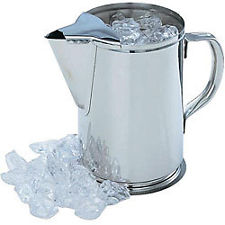
When restaurant servers re-fill the water glass, why do they always pour the water over the side of the pitcher, instead of through the spout? While I appreciate that the water I’m getting is nice and cold (which means we’re not in Europe), every time they do it, I end up with more ice in my glass, even when the spout has an ice catcher. By the third re-fill, the frozen-water to liquid-water ratio has tipped so far that it’s impossible for me to take a sip without having ice cubes slam into my nose.
And stop putting lemons in the water. All I want is a sip of that nice clear liquid, and now I have to make a mental note to avoid a seed that came loose and is floating around in there. If you want lemons — or limes, or cherries, or cantaloupe — in your water, ask for it. The default should be nothing but hydrogen and oxygen in the glass.
At the other end of the restaurant temperature spectrum, it’s not necessary to tell me that the plate you’re bringing me — full of food straight from the kitchen — is hot. Unless you’re serving me on paper plates, I expect the laws of thermal conduction to apply. Besides, no matter how often you say that, we always have to touch the plate anyway. I may need to adjust its placement an inch or two one way or the other, or I may just be a guy, and that’s what guys do — test claims.
I’m sure some lawyer started this, advising a restaurateur that if his staff didn’t warn customers about their plates being hot, some moron would grab onto the dinnerware until his skin blistered, and then there would be a lawsuit. If you’re that worried about the litigiousness of your clientele, perhaps you’d better remind every couple that orders a bottle of wine that it contains alcohol, or warn the possibly-allergic that the pecan-pie-a-la-mode contains nuts, or that if you sit at this table, the air conditioner is going to keep blowing down your neck throughout the entire meal.
Here’s how I always know the plate is hot: it wasn’t poured out of a pitcher with a few dozen ice cubes.
